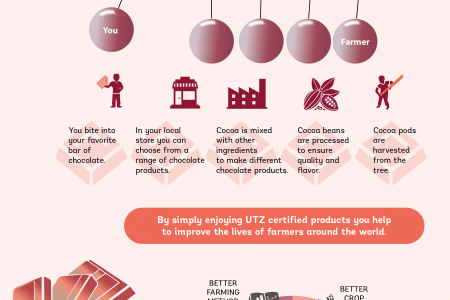
US Farming 101
U.S. Farming 10I for food and nutrition professionals The Academy of Nutrition and Dietetics Foundation's Future of Food initiative addresses Academy members' interest in learning more about a safe, nutritious food supply. It's amazing to learn about farmers and all that they do to grow food for the U.S. and the world! This infographic is based on information presented in two recent webinars: US Farming 101 part 1 http://www.eatright.org/Foundation/content.aspx?id%=6442481905 and US Farming 101 part 2 http://www.eatright.org/Foundation/content.aspx?id=6442482164 Who Grows Our Food? A Profile of Anmerican Farmers Average age of a farmer ? 58 in the U.S. is While less than 2% of US population are farmers, they help to feed 100% of the US population!" 20-30 30-40 40-50 50-60 60-70 9 out of every 10 farmers have some college education or a 4-year degree 8.5 out of every 10 farmers is male Fast Facts About U.S. Farms Most Farms are Family Farms 5% corpe corporate farms 7% family partnerships* farms 87% operated by families* 2.1 million farms in U.S. * 915 million farm acres in the U.S. 5 Diversification Many farmers grow crops and also raise livestock to: Support future farm generations Add income streams to support family business Efficiently feed livestock with food grown on the farm Reduce Meet consumer financial risk demand Understanding Different Types of Farming Systems Conventional Uses modern technology and mechanization to advance agriculture productivity, efficiency, and conserve natural resources 6 Provides abundant and inexpensive food 6 Between 70-90% of the recent increase in food production is attributed to increased yield due to advances in science-based agriculture Biotechnology Used to increase agricultural productivity and improve plants, animals, microorganisms and soil health 8 Organizations such as the USDA support advances in agriculture, including biotechnology, and help to ensure a safe food supply Organic Uses methods to preserve the environment, and avoids most synthetic materials, including pesticides and antibiotics 10 USDA has specific organic standards in the Organic Foods Production Act that farms must meet to be USDA Organic Certified 1º 5.4 million organic farm acres in the U.S. (0.5% of all farm acres) 5 A look at Organic Foods in 2012: Organic food sales increased by over 7%" Organic food sales account for 3.5 % of total food sales in U.S. " Which method is the best ? There are benefits to all 3 systems. Many farmers incorporate a variety of farming systems to provide a nutritious, safe, and sustainable food supply. Take Action There are many ways food and nutrition professionals can support agriculture and farmers in our community ) Get to know a farmer Get involved or help organize a Farm-to-School Visit and/or Contact your local Farm Bureau and volunteer at your local farmers' University Cooperative Extension Office to market program learn more Become a Master Attend Learn to garden Gardener (contact your local Cooperative Extension for information) agriculture-related seminars 2 Promote the reduction of food waste 40% of food waste comes 60% from homes and food of food in the service - this is mostly U.S. is never eaten - this is among the highest globally 2 avoidable12 Food waste is the 2nd largest category of municipal solid waste2 Ways to reduce food waste Donate safe, Freeze nutritious food to food food banks before it spoils Teach about food Incdlude shopping, storage and preparation tips when distributing recipes date labels and how to use compost food scraps Order or buy only what you will eat-ask for and Take restaurant leftovers home encourage restaurants to offer smaller portions Visit Get creative with homefoodsafety.org leftovers from home meals 3 Support locally grown food Teach preparation of fresh produce from farmers' markets, Community Supported Agriculture (CSAS), etc. (demos, handouts, blogs, articles, etc.) Shop farmers' Patronize and markets compliment restaurants that buy locally Produce a local foods directory Buy at grocery stores that sell from local growers Teach people how to preserve locally Organize trips to local farms Work with youth to grown foods grow food National Center for Home Plant a garden Food Preservation nchfp.uga.edu Learn more: • Join the FCP new subgroup on Agriculture www.foodculinaryprofs.org • Join HEN DPG www.hendpg.org • Engage in social media and follow respected agriculture organizations (view resources from HEN and FCP) • Join Kids Eat Right www.kidseatright.org/volunteer • Get involved in the food policy scene in your own community • USDA Know Your Farmer, Know Your Food Compass www.usda.gov/wps/portal/usda/usdahome?navid=KYF_COMPASS • USDA Know Your Farmer, Know Your Food www.usda.gov/wps/portal/usda/knowyourfarmer?navid=KNOWYOURFARMER Sources: 1. USDA 2012 Census of Agriculture Highlights. Farm Demographics. ACH 12-3/May 2014. http://www.agcensus.usda.gov/Publications/2012/0nline_Resources/Highlights/Farm_Demographics/Highlights Farm Demographics.pdf Accessed 10-9-14. 2. 2012 Census of Agriculture http://www.agcensus.usda.gov/Publications/2012/Online_Resources/Ag Atlas_Maps/Operators/Characteristics/12-M123-RGBChor-largetext.pdf Accessed 10-3-14. 3. Ilg. R. The Changing Face of Fam Employment. Monthly Labor Review. 1995. http://stats.bls.gov/mlr/1995/04/art1full.pdf Accessed 6-13-14. 4. USDA Census of Agriculture. 2012 Census Ag Atlas Maps http://www.agcensus.usda.gov/Publications/2012/0nline_Resources/Ag Atlas_Maps/Operators/ Accessed 6-13-14. 5. USDA Economic Research Service. http://www.ers.usda.gov/topics/natural-resources-environment/organic-agriculture/organic-trade.aspx#.U5oL6vldUdo Accessed 6-13-14. 6. USDA National Agriculture Libraray. Sustainable Agriculture: Definitions and Terms. http://www.nal.usda.gov/afsic/pubs/terms/srb9902.shtml#toc1 Accessed 10-8-14. 7. Agricultural Sector Review. Washington, DC: The World Bank, Agricultural and Natural Resources Department; 1993. 8. U.S. Agency for International Development, Agriculture Biotechnology Support Project I, and the Program for Biosafety Systems. Brief #1:Agriculture Biotechnology. http://absp2.comell.edu/resources/briefs/documents/warp_briefs_eng_scr.pdf Accessed 10-8-14. 9. USDA Agriculture Biotechnology webpage. http://www.usda.gov/wps/portal/usda/usdahome?navid=BIOTECH. Accessed 10-31-14. 10. USDA. Organic Agriculture. http://www.usda.gov/wps/portal/usda/usdahome?contentidonly=true&contentid=Dorganic-agriculture.html Accessed 10-8-14. 11. USDA. Economic Research Service. Consumer demand drives growth in the organic food sector. http://www.ers.usda.gov/data-products/chart-gallery/detail.aspx?chartld=35003#VDQ0pfldX14 Accessed 10-8-14. 12. Reich, A. and Foley, J. Food Loss and Waste in in in the US: The Science Behind the Supply Chain, Institute on the Environment, University of Minnesota. April 2014. http://www.foodpolicy.umn.edu/prod/groups/cvm/@pub/@cvm/@fprc/documents/content/cvm_content_477272.pdf Accessed 6-13-14. eat Academyof Nutrition right. and Dietetics Foundation Future of Food Initiative www.eatright.org/foundation This infographic was developed as part of the Future of Food initiative through an educational grant to the Academy of Nutrition and Dietetics Foundation from Elanco
US Farming 101
Writer
Source
Unknown. Add a sourceCategory
EnvironmentGet a Quote










